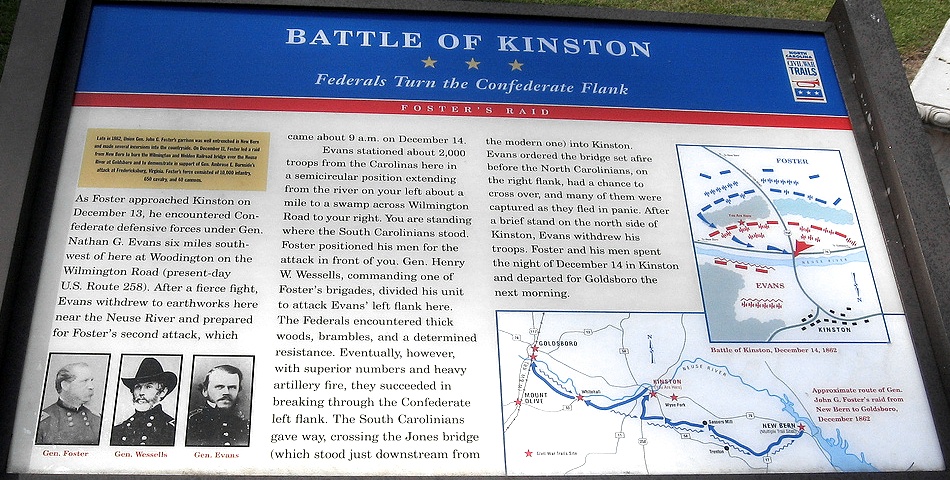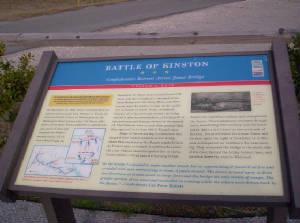|
First Battle of Kinston
Kinston and the American Civil War
Battle of Kinston
Kinston,
North Carolina
Other Names: First Battle of Kinston, Kinston 1
Location: Lenoir County, North Carolina
Campaign: Goldsboro Expedition, aka Goldsborough Expedition (December 1862)
Date(s): December 14, 1862
Principal Commanders: Brig. Gen. John G. Foster [US]; Brig. Gen.
Nathan Evans [CS]
Forces Engaged: Department of North Carolina, 1st Division [US];
Evans’s Brigade [CS]
| Kinston Bridge |

|
| Photograph is Courtesy William Garrison Reed, New Bern-Craven County Public Library |
Estimated Casualties: 685 total
Result(s): Union victory
Description: A Union expedition led by Brig. Gen. John G. Foster
left New Berne (aka New Bern) in December to disrupt the Wilmington & Weldon
Railroad at Goldsborough. (North Carolina American Civil War Railroads) The advance was stubbornly contested by Evans’s Brigade near Kinston Bridge on December 14, but the Confederates
were outnumbered and withdrew north of the Neuse River in the direction of Goldsborough (aka Goldsboro). Foster continued
his movement the next day, taking the River Road, south of the Neuse River. (See: First Battle of Kinston and Battle of Kinston, North Carolina.)
"The enemy held their ground [at Kinston], however, with terrible
stubbornness; an almost hand to hand fight raged for hours." Words of a Union soldier from Jenney's Battery, New York
Artillery, shortly after the Battle of Kinston
| Battle of Kinston |

|
| Battle of Kinston |
| Civil War Battle of Kinston, North Carolina |

|
| Battle of Kinston |
Sources: National Park Service; Official Records of the Union and Confederate
Armies
Recommended Reading: The Civil War in the Carolinas (Hardcover). Description: Dan Morrill relates the experience of two quite different states bound together in
the defense of the Confederacy, using letters, diaries, memoirs, and reports. He shows
how the innovative operations of the Union army and navy along the coast and in the bays and rivers of the Carolinas
affected the general course of the war as well as the daily lives of all Carolinians. He demonstrates the "total war" for
North Carolina's vital coastal railroads and ports. In
the latter part of the war, he describes how Sherman's operation
cut out the heart of the last stronghold of the South. Continued below...
The author
offers fascinating sketches of major and minor personalities, including the new president and state governors, Generals Lee,
Beauregard, Pickett, Sherman, D.H. Hill, and Joseph E. Johnston. Rebels and abolitionists, pacifists and unionists, slaves
and freed men and women, all influential, all placed in their context with clear-eyed precision. If he were wielding a needle
instead of a pen, his tapestry would offer us a complete picture of a people at war. Midwest Book Review: The Civil War in the Carolinas by civil war expert and historian
Dan Morrill (History Department, University of North Carolina at Charlotte, and Director of the Charlotte-Mecklenburg Historical
Society) is a dramatically presented and extensively researched survey and analysis of the impact the American Civil War had
upon the states of North Carolina and South Carolina, and the people who called these states their home. A meticulous, scholarly,
and thoroughly engaging examination of the details of history and the sweeping change that the war wrought for everyone, The
Civil War In The Carolinas is a welcome and informative addition to American Civil War Studies reference collections.
Advance to:
Recommended Reading: Ironclads and Columbiads: The Coast (The Civil War in North Carolina)
(456 pages). Description: Ironclads and Columbiads
covers some of the most important battles and campaigns in the state. In January 1862, Union forces began in earnest to occupy
crucial points on the North Carolina coast. Within six months,
Union army and naval forces effectively controlled coastal North Carolina from the Virginia line south to present-day Morehead
City. Continued below...
Union setbacks in Virginia, however, led to the withdrawal of many federal soldiers from North Carolina,
leaving only enough Union troops to hold a few coastal strongholds—the vital ports and railroad junctions. The South
during the Civil War, moreover, hotly contested the North’s ability to maintain its grip on these key coastal strongholds.
Recommended Reading:
The Civil War in Coastal North Carolina (175 pages) (North Carolina Division
of Archives and History). Description: From the drama
of blockade-running to graphic descriptions of battles on the state's islands and sounds, this book portrays the explosive
events that took place in North Carolina's coastal region during the Civil War. Topics discussed include the strategic
importance of coastal North Carolina, Federal occupation
of coastal areas, blockade-running, and the impact of war on civilians along the Tar Heel coast.
Recommended Reading: Storm over Carolina: The Confederate
Navy's Struggle for Eastern North Carolina. Description: The struggle for control of the eastern waters of North Carolina during the War Between the States was a bitter, painful,
and sometimes humiliating one for the Confederate navy. No better example exists of the classic adage, "Too little, too late." Burdened
by the lack of adequate warships, construction facilities, and even ammunition, the South's naval arm fought bravely and even
recklessly to stem the tide of the Federal invasion of North Carolina from the raging Atlantic. Storm Over Carolina is the account of the
Southern navy's struggle in North Carolina waters and it
is a saga of crushing defeats interspersed with moments of brilliant and even spectacular victories. It is also the story
of dogged Southern determination and incredible perseverance in the face of overwhelming odds. Continued below...
For most of
the Civil War, the navigable portions of the Roanoke, Tar, Neuse,
Chowan, and Pasquotank rivers were occupied by Federal forces. The Albemarle and Pamlico sounds, as well as most of the coastal
towns and counties, were also under Union control. With the building of the river ironclads, the Confederate navy at last
could strike a telling blow against the invaders, but they were slowly overtaken by events elsewhere. With the war grinding
to a close, the last Confederate vessel in North Carolina
waters was destroyed. William T. Sherman was approaching from the south, Wilmington
was lost, and the Confederacy reeled as if from a mortal blow. For the Confederate navy, and even more so for the besieged
citizens of eastern North Carolina, these were stormy days
indeed. Storm Over Carolina describes their story, their struggle, their
history.
Recommended Reading: The Civil War
on the Outer Banks: A History of the Late Rebellion Along the Coast of North Carolina from Carteret to Currituck With Comments
on Prewar Conditions and an Account of (251 pages). Description: The ports at Beaufort, Wilmington, New Bern and Ocracoke, part of the Outer Banks (a chain of barrier
islands that sweeps down the North Carolina coast from the Virginia Capes to Oregon Inlet), were strategically vital
for the import of war materiel and the export of cash producing crops. From official records, contemporary newspaper accounts,
personal journals of the soldiers, and many unpublished manuscripts and memoirs, this
is a full accounting of the Civil War along the North Carolina
coast.
|

